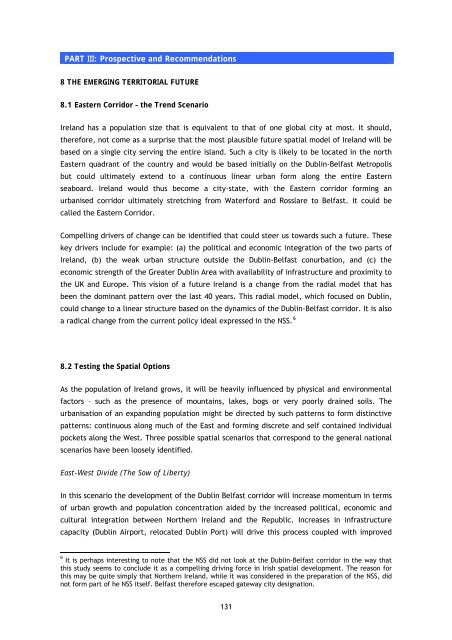TWICE THE SIZE - DIT Update - Dublin Institute of Technology
TWICE THE SIZE - DIT Update - Dublin Institute of Technology
TWICE THE SIZE - DIT Update - Dublin Institute of Technology
You also want an ePaper? Increase the reach of your titles
YUMPU automatically turns print PDFs into web optimized ePapers that Google loves.
PART III: Prospective and Recommendations<br />
8 <strong>THE</strong> EMERGING TERRITORIAL FUTURE<br />
8.1 Eastern Corridor – the Trend Scenario<br />
Ireland has a population size that is equivalent to that <strong>of</strong> one global city at most. It should,<br />
therefore, not come as a surprise that the most plausible future spatial model <strong>of</strong> Ireland will be<br />
based on a single city serving the entire island. Such a city is likely to be located in the north<br />
Eastern quadrant <strong>of</strong> the country and would be based initially on the <strong>Dublin</strong>-Belfast Metropolis<br />
but could ultimately extend to a continuous linear urban form along the entire Eastern<br />
seaboard. Ireland would thus become a city-state, with the Eastern corridor forming an<br />
urbanised corridor ultimately stretching from Waterford and Rosslare to Belfast. It could be<br />
called the Eastern Corridor.<br />
Compelling drivers <strong>of</strong> change can be identified that could steer us towards such a future. These<br />
key drivers include for example: (a) the political and economic integration <strong>of</strong> the two parts <strong>of</strong><br />
Ireland, (b) the weak urban structure outside the <strong>Dublin</strong>-Belfast conurbation, and (c) the<br />
economic strength <strong>of</strong> the Greater <strong>Dublin</strong> Area with availability <strong>of</strong> infrastructure and proximity to<br />
the UK and Europe. This vision <strong>of</strong> a future Ireland is a change from the radial model that has<br />
been the dominant pattern over the last 40 years. This radial model, which focused on <strong>Dublin</strong>,<br />
could change to a linear structure based on the dynamics <strong>of</strong> the <strong>Dublin</strong>-Belfast corridor. It is also<br />
a radical change from the current policy ideal expressed in the NSS. 6<br />
8.2 Testing the Spatial Options<br />
As the population <strong>of</strong> Ireland grows, it will be heavily influenced by physical and environmental<br />
factors – such as the presence <strong>of</strong> mountains, lakes, bogs or very poorly drained soils. The<br />
urbanisation <strong>of</strong> an expanding population might be directed by such patterns to form distinctive<br />
patterns: continuous along much <strong>of</strong> the East and forming discrete and self contained individual<br />
pockets along the West. Three possible spatial scenarios that correspond to the general national<br />
scenarios have been loosely identified.<br />
East-West Divide (The Sow <strong>of</strong> Liberty)<br />
In this scenario the development <strong>of</strong> the <strong>Dublin</strong> Belfast corridor will increase momentum in terms<br />
<strong>of</strong> urban growth and population concentration aided by the increased political, economic and<br />
cultural integration between Northern Ireland and the Republic. Increases in infrastructure<br />
capacity (<strong>Dublin</strong> Airport, relocated <strong>Dublin</strong> Port) will drive this process coupled with improved<br />
6 It is perhaps interesting to note that the NSS did not look at the <strong>Dublin</strong>-Belfast corridor in the way that<br />
this study seems to conclude it as a compelling driving force in Irish spatial development. The reason for<br />
this may be quite simply that Northern Ireland, while it was considered in the preparation <strong>of</strong> the NSS, did<br />
not form part <strong>of</strong> he NSS itself. Belfast therefore escaped gateway city designation.<br />
131








